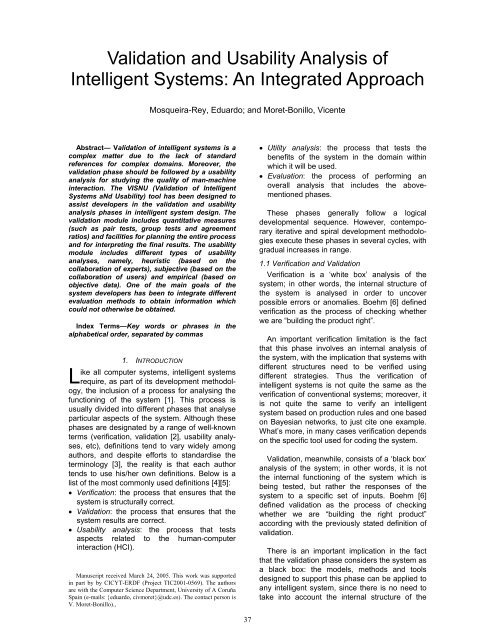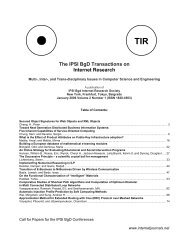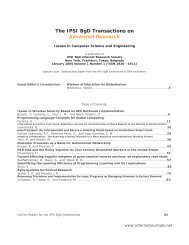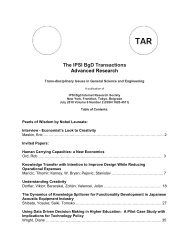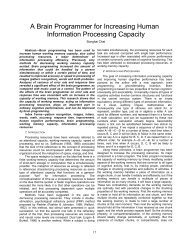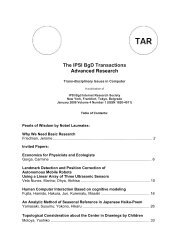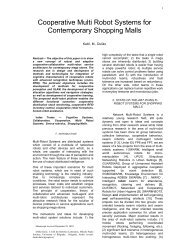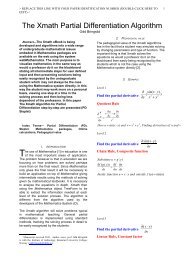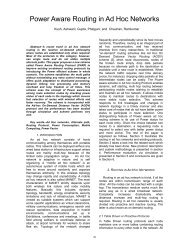Submited Paper (click here to see)
Submited Paper (click here to see)
Submited Paper (click here to see)
Create successful ePaper yourself
Turn your PDF publications into a flip-book with our unique Google optimized e-Paper software.
Validation and Usability Analysis of<br />
Intelligent Systems: An Integrated Approach<br />
Mosqueira-Rey, Eduardo; and Moret-Bonillo, Vicente<br />
Abstract— Validation of intelligent systems is a<br />
complex matter due <strong>to</strong> the lack of standard<br />
references for complex domains. Moreover, the<br />
validation phase should be followed by a usability<br />
analysis for studying the quality of man-machine<br />
interaction. The VISNU (Validation of Intelligent<br />
Systems aNd Usability) <strong>to</strong>ol has been designed <strong>to</strong><br />
assist developers in the validation and usability<br />
analysis phases in intelligent system design. The<br />
validation module includes quantitative measures<br />
(such as pair tests, group tests and agreement<br />
ratios) and facilities for planning the entire process<br />
and for interpreting the final results. The usability<br />
module includes different types of usability<br />
analyses, namely, heuristic (based on the<br />
collaboration of experts), subjective (based on the<br />
collaboration of users) and empirical (based on<br />
objective data). One of the main goals of the<br />
system developers has been <strong>to</strong> integrate different<br />
evaluation methods <strong>to</strong> obtain information which<br />
could not otherwise be obtained.<br />
Index Terms—Key words or phrases in the<br />
alphabetical order, separated by commas<br />
1. INTRODUCTION<br />
ike all computer systems, intelligent systems<br />
L require, as part of its development methodology,<br />
the inclusion of a process for analysing the<br />
functioning of the system [1]. This process is<br />
usually divided in<strong>to</strong> different phases that analyse<br />
particular aspects of the system. Although these<br />
phases are designated by a range of well-known<br />
terms (verification, validation [2], usability analyses,<br />
etc), definitions tend <strong>to</strong> vary widely among<br />
authors, and despite efforts <strong>to</strong> standardise the<br />
terminology [3], the reality is that each author<br />
tends <strong>to</strong> use his/her own definitions. Below is a<br />
list of the most commonly used definitions [4][5]:<br />
• Verification: the process that ensures that the<br />
system is structurally correct.<br />
• Validation: the process that ensures that the<br />
system results are correct.<br />
• Usability analysis: the process that tests<br />
aspects related <strong>to</strong> the human-computer<br />
interaction (HCI).<br />
Manuscript received March 24, 2005. This work was supported<br />
in part by by CICYT-ERDF (Project TIC2001-0569). The authors<br />
are with the Computer Science Department, University of A Coruña<br />
Spain (e-mails: {eduardo, civmoret}@udc.es). The contact person is<br />
V. Moret-Bonillo).,<br />
• Utility analysis: the process that tests the<br />
benefits of the system in the domain within<br />
which it will be used.<br />
• Evaluation: the process of performing an<br />
overall analysis that includes the abovementioned<br />
phases.<br />
These phases generally follow a logical<br />
developmental sequence. However, contemporary<br />
iterative and spiral development methodologies<br />
execute these phases in several cycles, with<br />
gradual increases in range.<br />
1.1 Verification and Validation<br />
Verification is a ‘white box’ analysis of the<br />
system; in other words, the internal structure of<br />
the system is analysed in order <strong>to</strong> uncover<br />
possible errors or anomalies. Boehm [6] defined<br />
verification as the process of checking whether<br />
we are “building the product right”.<br />
An important verification limitation is the fact<br />
that this phase involves an internal analysis of<br />
the system, with the implication that systems with<br />
different structures need <strong>to</strong> be verified using<br />
different strategies. Thus the verification of<br />
intelligent systems is not quite the same as the<br />
verification of conventional systems; moreover, it<br />
is not quite the same <strong>to</strong> verify an intelligent<br />
system based on production rules and one based<br />
on Bayesian networks, <strong>to</strong> just cite one example.<br />
What’s more, in many cases verification depends<br />
on the specific <strong>to</strong>ol used for coding the system.<br />
Validation, meanwhile, consists of a ‘black box’<br />
analysis of the system; in other words, it is not<br />
the internal functioning of the system which is<br />
being tested, but rather the responses of the<br />
system <strong>to</strong> a specific set of inputs. Boehm [6]<br />
defined validation as the process of checking<br />
whether we are “building the right product”<br />
according with the previously stated definition of<br />
validation.<br />
T<strong>here</strong> is an important implication in the fact<br />
that the validation phase considers the system as<br />
a black box: the models, methods and <strong>to</strong>ols<br />
designed <strong>to</strong> support this phase can be applied <strong>to</strong><br />
any intelligent system, since t<strong>here</strong> is no need <strong>to</strong><br />
take in<strong>to</strong> account the internal structure of the<br />
37
system or the <strong>to</strong>ol used for its design. One of the<br />
first works containing an analysis of the validation<br />
phase was an article by O’Keefe et al. [7]. In this<br />
article, important questions in relation <strong>to</strong><br />
validation were posed, for example: What do we<br />
evaluate? What data do we use for the<br />
validation? How do we evaluate? Who should be<br />
involved in the process? Further articles on the<br />
subject were subsequently published by O’Keefe<br />
and O’Leary [8] and by Gupta [9]. A description of<br />
the main verification and validation <strong>to</strong>ols between<br />
the years 1985-1995 can be found in [10].<br />
Of all the issues raised by validation, probably<br />
the most important question is in relation <strong>to</strong> the<br />
validation criterion. In other words, if validation<br />
treats the system as a black box and only<br />
analyses its outputs, then we require a criterion<br />
that will indicate whether these outputs are<br />
correct or otherwise. This poses no particular<br />
validation problems with conventional systems,<br />
given that it is a relatively simple matter <strong>to</strong> check<br />
whether an algorithm produces the expected<br />
results. However, for intelligent systems that<br />
model human knowledge, the identification of a<br />
validation criterion is more problematic. In<br />
practice, one of two approaches <strong>to</strong> validation are<br />
typically taken, defined according <strong>to</strong> the kind of<br />
criterion used:<br />
• Validation against the problem: A standard<br />
reference exists that is used <strong>to</strong> test that the<br />
system results are correct.<br />
• Validation against the expert: No standard<br />
reference exists and so system interpretations<br />
must be compared with those of human<br />
experts from the domain.<br />
Validation against the problem is the more<br />
ideal approach; it generally relies on measures<br />
such as true/false positive/negative ratios, which<br />
are combined in graphs such as ROC curves<br />
(Receiver Operating Characteristic) [11].<br />
Should this approach not be possible, then<br />
evaluation against the expert is the next best<br />
alternative. To avoid subjectivity in the validation<br />
process, it is recommended that several experts<br />
(not involved in the design of the system) be<br />
used. The ideal approach consists of a standard<br />
reference obtained by means of the experts<br />
reaching a consensus in their interpretations<br />
using a technique such as Delphi [12].<br />
Nonetheless, the process of developing a<br />
consensus is both slow and costly, and so the<br />
normal procedure is for the experts <strong>to</strong> work<br />
individually. This has the advantage, however, of<br />
permitting an analysis of any inconsistencies that<br />
may arise in individual interpretations.<br />
Another problem of validating an intelligent<br />
system against a group of experts is that the<br />
volume of information obtained is high, and this<br />
requires the use of statistical and multivariate<br />
analysis techniques <strong>to</strong> facilitate the interpretation.<br />
1.2 Usability and Utility<br />
Verification and validation have been<br />
performed in conjunction on so many occasions<br />
that they have jointly become known as ‘V&V’.<br />
Nonetheless, more recently, usability and utility<br />
analyses have been attracting the interest of<br />
system developers, above all as a consequence<br />
of applications becoming accessible <strong>to</strong><br />
individuals without computer knowledge, through<br />
networks such as the Internet and applications<br />
such as the World Wide Web [13][14].<br />
W<strong>here</strong>as verification and validation are<br />
concerned with system functioning, usability<br />
analyses endeavour <strong>to</strong> evaluate aspects that go<br />
beyond correctness of results and that involve<br />
the quality of the man-machine interaction. Utility<br />
analysis, on the other hand, rather than<br />
evaluating whether the system is usable,<br />
evaluates whether it can bring additional benefits<br />
<strong>to</strong> users. Although usability and utility are two<br />
distinct evaluation phases, in practice both are<br />
analysed jointly. Adelman and Riedel [4], for<br />
example, provide a questionnaire for a joint<br />
analysis of both phases.<br />
T<strong>here</strong> are many usability analysis techniques<br />
available, which various authors have classified<br />
in different ways. Preece [15], for example,<br />
classified usability analyses as analytic, expert,<br />
observational, survey and experimental. Another<br />
interesting work by Ivory and Hearst [16] includes<br />
a classification of usability analysis techniques<br />
and <strong>to</strong>ols in terms of the four dimensions of<br />
method class, method type, au<strong>to</strong>mation type and<br />
effort level. The method class category (equivalent<br />
<strong>to</strong> Preece’s classification) includes testing,<br />
inspection, inquiry, analytical modelling and<br />
simulation. In our research we have preferred the<br />
Adelman and Riedel classification, which identifies<br />
three types of techniques for analysing<br />
usability:<br />
• Heuristic: These techniques are based on the<br />
opinions of usability experts, who analyse the<br />
system and determine strengths and weaknesses<br />
from an end-user perspective.<br />
• Subjetive: These techniques are based on the<br />
opinions of the system users, who analyse<br />
operational pro<strong>to</strong>types and give their opinions<br />
on the usability of these pro<strong>to</strong>types.<br />
• Empirical: These techniques, which are based<br />
on the actions of the system users, function on<br />
the basis of obtaining objective data on<br />
practical use of the system.<br />
These techniques are not necessarily mutually<br />
exclusive; for example, one post-event pro<strong>to</strong>col<br />
38
consists of a video recording of system-user<br />
interactions that is subsequently commented on<br />
by the user. Thus, an empirical element is filtered<br />
through a subjective interpretation provided by<br />
the user.<br />
1.3 Aims<br />
This paper describes the VISNU (Validation of<br />
Intelligent Systems aNd Usability) <strong>to</strong>ol, designed<br />
specifically <strong>to</strong> assist in the development of<br />
validation and usability analyses for intelligent<br />
systems. The most important features of VISNU<br />
are as follows:<br />
• It integrates different methods and approaches<br />
for evaluating intelligent systems in one<br />
product.<br />
• It includes novel aspects such as the use of<br />
artificial intelligence techniques for the<br />
interpretation of results.<br />
• It integrates the results of different analysis<br />
methods so as <strong>to</strong> obtain information that could<br />
not be obtained by results interpreted in<br />
isolation.<br />
Verification aspects have been excluded<br />
simply <strong>to</strong> ensure that the <strong>to</strong>ol can be applied <strong>to</strong><br />
as many systems as possible, regardless of the<br />
knowledge representation paradigm used.<br />
The paper is laid out as follows: section 2<br />
describes the VISNU architecture and modules;<br />
section 3 shows some examples of the application<br />
of VISNU; and finally, sections 4 and 5, respectively,<br />
contain discussion and conclusions.<br />
2. METHODS<br />
VISNU’s novel contribution lies in its<br />
integration of several evaluation techniques in a<br />
single <strong>to</strong>ol and the possibilities it offers for the<br />
combined functioning of some of these<br />
techniques. Table 1 provides a summary of the<br />
different techniques implemented in VISNU, <strong>to</strong> be<br />
commented in more detail below.<br />
The validation module is divided in<strong>to</strong> three<br />
main parts: (1) planning: that establishes the<br />
main validation strategies, (2) application: that<br />
calculates a series of quantitative measures (pair<br />
measures, group measures and agreement<br />
ratios) for analysing the intelligent system results<br />
and (3) interpretation: that tries <strong>to</strong> elucidate<br />
whether the intelligent system is really behaving<br />
as an expert within its field of application.<br />
As for usability three kinds of techniques are<br />
considered: (1) heuristic techniques: such as the<br />
creation of GOMS [17] (Goals, Opera<strong>to</strong>rs,<br />
Methods and Selection rules) models or<br />
ergonomic checklists. (2) subjective measures:<br />
for obtaining the opinions of users, in the form of<br />
closed questionnaires that can be analysed using<br />
MAUT [18] (Multi-Attribute Utility Theory) or AHP<br />
[19] (Analytic Hierarchy Process). And, (3)<br />
empirical techniques: such as statistical analyses<br />
for log files, identification of hierarchical tasks<br />
from log files and the possibility for instantiating<br />
GOMS models from logs and comparing<br />
predictions a priori with results a posteriori.<br />
TABLE 1. EVALUATION TOOLS<br />
INTEGRATED IN VISNU<br />
● Planning of validation<br />
Planning<br />
process<br />
● Agreement index<br />
● Within-one agreem. index<br />
● Kappa<br />
Pair<br />
● Weighted kappa<br />
measures<br />
● Spearman’s rho<br />
● Kendall’s tau and tau b<br />
● Goodman-Kruskal gamma<br />
Validation<br />
Usability<br />
Group<br />
measures<br />
Ratios<br />
Interpretation<br />
Heuristic<br />
Subjective<br />
Empirical<br />
● Williams index<br />
● Hierarchical cluster<br />
● Multidimensional scaling<br />
● True/false<br />
positive/negative ratios<br />
● ROC curves<br />
● Jaccard coefficient<br />
● Heuristic interpretation of<br />
validation results<br />
● GOMS models<br />
● Ergonomic checklists<br />
● MAUT questionnaires<br />
● AHP questionnaires<br />
● Log analysis<br />
● Task analysis<br />
● GOMS-log integration<br />
2.1 VISNU architecture<br />
The architecture of VISNU is based on objec<strong>to</strong>riented<br />
programming using design patterns [20].<br />
The inclusion of these patterns makes the <strong>to</strong>ol<br />
more flexible and extendable <strong>to</strong> future modifications,<br />
so the inclusion of new modules or the<br />
modification of existing modules does not affect<br />
the other modules in the system. The VISNU<br />
project is based on the following four clearly<br />
differentiated modules (Fig. 1):<br />
• gui: this includes the code for implementing the<br />
main graphical user interface that supports the<br />
interfaces for the different modules.<br />
• util: this contains the helper software for the<br />
other modules.<br />
• validation: this includes the modules designed<br />
for carrying out the validation processes,<br />
among which the most important are: (1) gui:<br />
the validation module interface, (2) planning:<br />
the planning system, (3) measures:<br />
quantitative validation measures, and (4)<br />
interpretation: the interpretation system.<br />
• usability: this includes the modules designed<br />
for carrying out the usability analysis proce-<br />
39
dures, among which the most important are:<br />
(1) maut: that implements questionnaires that<br />
can be analysed using MAUT, (2) ahp: that<br />
implements questionnaires that can be<br />
analysed using AHP, (3) logging: that<br />
implements the GOMS analysis, log analysis<br />
and the GOMS-log integration.<br />
visnu<br />
gui<br />
validation<br />
util<br />
usability<br />
measures is depicted in Fig. 2.<br />
Table 2. Criteria <strong>to</strong> be analysed in the planning<br />
phase<br />
Subject<br />
Application<br />
domain<br />
System<br />
Developmen<br />
t phase<br />
Criteria <strong>to</strong> be analysed<br />
● Critical domains<br />
● Validation criteria<br />
● End-user profile<br />
● Division in sub-systems<br />
● Uncertainty management<br />
● Type of output variables<br />
● Type of problem in hand<br />
● Relationship with the<br />
environment<br />
● Initial phases<br />
● Intermediate phases<br />
● Final phases<br />
gui<br />
planning<br />
measures<br />
interpretation<br />
maut<br />
ahp<br />
logging<br />
Data cases<br />
Validation<br />
strategies<br />
Fig. 1. VISNU modules.<br />
The following sections will describe the<br />
validation and usability modules in more detail.<br />
2.2 Validation module<br />
The validation module in VISNU was<br />
developed on the basis of previous work<br />
performed by the authors on the validation <strong>to</strong>ol<br />
SHIVA (System for Heuristic and Integrated<br />
Validation) [21]. This <strong>to</strong>ol was designed<br />
according <strong>to</strong> a methodology that divided the<br />
process in<strong>to</strong> three phases, namely, planning,<br />
application, and interpretation.<br />
2.3 Planning<br />
With a view <strong>to</strong> determining the most suitable<br />
validation strategies, the planning phase involves<br />
an analysis of the system characteristics, the<br />
application domain and the development phase.<br />
Table 2 shows the criteria that are analysed in<br />
the validation planning process. For example, if<br />
the outputs of the system follow an ordinal scale,<br />
the most suitable approach is <strong>to</strong> weight the<br />
discrepancies according <strong>to</strong> importance (for<br />
example, in the symbolic processing of a given<br />
variable, a discrepancy between the categories<br />
‘very high’ and ‘slightly high’ is not quite the same<br />
as between the categories ‘very high’ and ‘very<br />
low’). Weighted kappa or the within-one agreement<br />
index are highly appropriate measures for<br />
taking discrepancies in<strong>to</strong> account. Further details<br />
of the planning module are <strong>to</strong> be found in [21].<br />
2.4 Application<br />
The application phase applies the strategies<br />
identified in the planning phase by making<br />
quantitative measurements using test data. The<br />
procedure for calculating the different quantitative<br />
Initial process<br />
Pair measures<br />
calculation<br />
Group measures<br />
calculation<br />
Contingency<br />
tables<br />
Pair<br />
measures<br />
Group<br />
measures<br />
Fig. 2. Procedure for obtaining quantitative<br />
validation measures.<br />
The first step is <strong>to</strong> analyse the existing test<br />
cases according <strong>to</strong> the validation strategies<br />
identified in the planning phase. This initial<br />
analysis permits us <strong>to</strong> construct contingency<br />
tables that correlate the interpretations of each of<br />
the possible pairs that can be formed between<br />
the experts that participate in the validation<br />
process (including the intelligent system).<br />
Contingency tables will serve as the basis for<br />
the construction of pair measures, such as kappa<br />
or the agreement index, that provide an index<br />
that quantifies coincidences between the<br />
interpretations of two experts. Fig. 3 illustrates a<br />
contingency table and the pair tests obtained<br />
from it.<br />
These pair measures can be used as input for<br />
the calculation of group measures, such as<br />
cluster analysis or MDS [22] (Multi-Dimensional<br />
Scaling) the objective of which is <strong>to</strong> analyse<br />
<strong>to</strong>gether the interpretations of the experts and <strong>to</strong><br />
endeavour <strong>to</strong> find representation structures that<br />
permit an easier interpretation within the context<br />
of the validation. In Fig. 4 we can <strong>see</strong> a bubble<br />
graph that integrates clustering information with<br />
MDS information.<br />
40
Fig. 3. Contingency table and pair tests.<br />
Fig. 4. Bubble graph integrating clusters and<br />
MDS information.<br />
The advantage of VISNU is that it integrates all<br />
the validation techniques in a single module of<br />
the <strong>to</strong>ol and the overall process can, t<strong>here</strong>fore,<br />
be easily performed by the user. A description of<br />
these measurements can be found in [21].<br />
2.5 Interpretation<br />
The final phase, interpretation, involves an<br />
analysis of the results obtained in the application<br />
phase, with a view <strong>to</strong> testing whether the<br />
intelligent system genuinely behaves as yet<br />
another expert in the domain.<br />
obtain the final interpretation results [23]. The fact<br />
that the algorithmic module filters and processes<br />
the basic data <strong>to</strong> convert them in<strong>to</strong> high-level<br />
information permits the rules of the heuristic<br />
module <strong>to</strong> be defined with an economy of<br />
expression.<br />
2.6 Usability module<br />
The VISNU usability module is designed <strong>to</strong><br />
provide support for the different usability analysis<br />
techniques - heuristic, subjective and empirical<br />
(<strong>see</strong> Table 1). The following sections will briefly<br />
describe the different implemented techniques.<br />
2.7 MAUT analysis<br />
MAUT (Multi-Attribute Utility Theory) analysis is<br />
a formal subjective multi-criterion analysis<br />
technique, employed in usability environments <strong>to</strong><br />
assess the utility of systems or alternatives that<br />
have more than one evaluable attribute [18]. The<br />
procedure for a MAUT analysis is as follows: (1)<br />
specification of the evaluation criteria and<br />
attributes; (2) weighting of these criteria and<br />
attributes according <strong>to</strong> their relative importance<br />
on a subjective manner, which leads <strong>to</strong> a<br />
subjective interpretation through an objective<br />
methodology; (3) testing how the system<br />
complies with each of the defined attributes; (4)<br />
creation of utility functions that will convert the<br />
above scores in<strong>to</strong> utility measures; (5) integration<br />
of the utility values obtained for each attribute<br />
in<strong>to</strong> a single measure; and (6) sensitivity<br />
analysis.<br />
MAUT is very suitable for validating closed<br />
questionnaires (for which responses are<br />
restricted <strong>to</strong> a closed set of options). In our case<br />
the questions are used <strong>to</strong> obtain values for the<br />
attributes in our MAUT tree. Fig. 5 shows a<br />
hierarchical tree established <strong>to</strong> calculate the<br />
overall utility of a computer system [4]. It can be<br />
observed how the different attributes of the tree<br />
have been weighted according <strong>to</strong> their relative<br />
importance.<br />
To facilitate the implementation of the<br />
interpretation phase it was decided <strong>to</strong> develop an<br />
expert system that would analyse the statistical<br />
results obtained in the application phase and<br />
draw conclusions on the performance of the<br />
intelligent system being validated.<br />
The expert interpretation system is composed<br />
of two modules: an algorithmic module, based on<br />
the unprocessed data for the statistical<br />
measures, which produces output in the form of<br />
high-level information; and a heuristic module<br />
that processes this high-level information <strong>to</strong><br />
41
Fig. 5. MAUT criteria and attributes tree.<br />
The questionnaire is developed by associating<br />
questions <strong>to</strong> attributes in the hierarchical MAUT<br />
tree. Because the questions do not need <strong>to</strong> have<br />
equivalent importance levels they can be<br />
weighted accordingly. The results of the evaluation<br />
of the responses <strong>to</strong> the questionnaire will<br />
give us an overall utility measure for the system<br />
being evaluated. The MAUT analysis can also be<br />
used <strong>to</strong> evaluate ergonomic checklists developed<br />
<strong>to</strong> perform a heuristic analysis of usability.<br />
2.7 AHP analysis<br />
One of the drawbacks <strong>to</strong> a MAUT analysis is<br />
that suitable utility functions need <strong>to</strong> be<br />
established for each study. To avoid the need <strong>to</strong><br />
define such functions, another multi-criterion<br />
method can be used, namely, the AHP (Analytic<br />
Hierarchy Process). Developed by Saaty [19],<br />
AHP has an additional advantage over MAUT in<br />
that it permits a formal treatment of the<br />
inconsistencies that may appear in the analysis.<br />
The drawback <strong>to</strong> AHP is that it is a<br />
comparative analysis, in other words, it is unable<br />
<strong>to</strong> reflect the utility of a single system in isolation,<br />
merely the utility of one system compared with an<br />
alternative system. AHP has other disadvantages,<br />
such as controversial ratio scales used <strong>to</strong><br />
make the pair comparisons, or the rank reversal<br />
problem, which basically means that the AHP<br />
results may change if the number of alternatives<br />
changes.<br />
The AHP module of VISNU can read criteria<br />
trees created for the MAUT questionnaires (Fig.<br />
5) what allows <strong>to</strong> analyse the same problem<br />
using different tests (AHP or MAUT).<br />
2.8 Log analysis<br />
As we have <strong>see</strong>n in previous sections, one of<br />
the most common ways of measuring how a<br />
system is used is through an analysis of log files.<br />
In other words, the system non-intrusively<br />
records its interactions with the end-user, and<br />
these interactions are subsequently analysed <strong>to</strong><br />
identify possible usability problems. The main<br />
drawback with the log method is that the data in<br />
the log files are generally low-level and lack<br />
context, which makes it difficult <strong>to</strong> identify the<br />
aims of the user when a log event was<br />
generated.<br />
The log <strong>to</strong>ol included in VISNU analyses log<br />
events and carries out an analysis of tasks, in<br />
other words, it identifies initial and final instants of<br />
the different tasks, errors and different device<br />
(mouse, keyboard, etc.) inputs that occur during<br />
the execution of a task. This task analysis<br />
permits the following information <strong>to</strong> be obtained:<br />
• A statistical analysis of all the tasks executed<br />
including mean duration in time, number of<br />
instances, number of errors, etc. (Fig. 6).<br />
• A hierarchical ordering of the tasks, with<br />
statistics about their composition (Fig. 7).<br />
• The instantiation of a pre-existing GOMS<br />
model (described further in the next section).<br />
Fig. 6. Statistics for different tasks identified from<br />
the log file.<br />
Fig. 7. Hierarchical structure for tasks identified<br />
from the log file and statistics about their<br />
composition.<br />
2.9 GOMS-log integration<br />
One of the novel aspects of VISNU is that it<br />
can not only make a GOMS-like heuristic<br />
analysis of usability, but can also integrate this<br />
information with the results of the empirical<br />
analysis performed by the log files. A GOMS<br />
analysis [17] is a formal analytical method for<br />
describing human-computer interaction in terms<br />
of Goals, Opera<strong>to</strong>rs, Methods and Selection<br />
rules. The main advantage of a GOMS model is<br />
that it predicts times or sequences for the<br />
execution of commands even before the system<br />
is developed. For example, Fig. 8 shows a simple<br />
GOMS analysis for the tasks necessary <strong>to</strong> add a<br />
new contact <strong>to</strong> an agenda.<br />
One of the main pitfalls of GOMS is that<br />
although it can be useful for the prediction of the<br />
normal user’s behaviour, abnormal behaviour is<br />
not considered. Another pitfall is that GOMS<br />
models are useful for those occasions w<strong>here</strong> one<br />
42
wishes <strong>to</strong> check minimization of the time needed<br />
<strong>to</strong> do a task, but less appropriate <strong>to</strong> check what<br />
tasks <strong>to</strong> do in the first place, how an application<br />
copes with different human behaviours, and how<br />
well the system is structured. Having that in mind<br />
GOMS can be considered as a valuable first step<br />
in the usability analysis.<br />
Fig. 8. GOMS model for creating a new contact.<br />
VISNU not only permits <strong>to</strong> define GOMS<br />
models, it also permits such GOMS models <strong>to</strong> be<br />
instantiated with data from the log files. To do<br />
this, the log files need <strong>to</strong> be able <strong>to</strong> identify<br />
different tasks which must be allocated <strong>to</strong><br />
different nodes in the GOMS tree (although this<br />
allocation does not need <strong>to</strong> be exhaustive, a<br />
more complete allocation will ensure a more<br />
accurate instantiation).<br />
An example of an instantiation of the GOMS<br />
tree of Fig. 8 is depicted in Fig. 9. In this figure<br />
we can compare time predictions made a priori<br />
by the GOMS tree with real a posteriori results<br />
obtained in the actual use of the system. More<br />
information about GOMS and logging integration<br />
can be found in [24].<br />
Fig. 9. GOMS model instantiated using a log file.<br />
2.10 Module integration<br />
The design aim for VISNU is a structure based<br />
on modules that are cohesive (abstractions that<br />
are logically related are grouped <strong>to</strong>gether) and<br />
loosely-coupled (dependence between modules<br />
is minimised). Fragmentation of a program in<br />
terms of individual components reduces complexity;<br />
it also creates a series of well-defined<br />
and well-documented frontiers within the<br />
program, which facilitates use and comprehension.<br />
Once the modules have been developed<br />
and tested separately, they are combined in a<br />
single application.<br />
Another aim of the VISNU developers has<br />
been <strong>to</strong> make this <strong>to</strong>ol available over the Internet<br />
by applying a rich-client philosophy. This<br />
philosophy has been adopted in view of the fact<br />
that web pages do not have the complexity<br />
necessary for the different modules of the<br />
application. Moreover, as the system is written in<br />
the Java programming language, it can be<br />
deployed via the Java Web Start platform, thus<br />
guaranteeing execution in any platform for which<br />
a Java virtual machine exists.<br />
3. APPLICATION EXAMPLES OF VISNU<br />
Both the VISNU <strong>to</strong>ol and its antecedent SHIVA<br />
have been used for validation and usability<br />
analysis for a number of intelligent systems<br />
developed in the Labora<strong>to</strong>ry for Research and<br />
Development in Artificial Intelligence (LIDIA) of<br />
the University of A Coruña, Spain. These<br />
systems are: PATRICIA [25], NST-EXPERT [26],<br />
CAFE [27], MIDAS [28] and SAMOA [29].<br />
PATRICIA is an intelligent moni<strong>to</strong>ring system<br />
for patients in Intensive Care Units. Given the<br />
critical nature of the domain, validation was<br />
performed against 6 human experts using group<br />
measures. Space does not permit a detailed<br />
description of the results of the validation for<br />
each of the PATRICIA modules. However, what<br />
we can say is that the results were more than<br />
satisfac<strong>to</strong>ry for all modules, and that the<br />
validation process did permit <strong>to</strong> explain the<br />
discrepancies identified.<br />
For example, in PATRICIA the result of the<br />
module for analysing the acid-base balance was<br />
used <strong>to</strong> establish the ventila<strong>to</strong>ry therapy of the<br />
patient. In the validation, however, it was<br />
discovered that although PATRICIA did not agree<br />
with the experts in the interpretation of the acidbase<br />
balance, the system did coincide in the<br />
therapy based on this interpretation. This fact can<br />
be <strong>see</strong>n in Fig. 10, in the left the results of<br />
PATRICIA (G) showed that is clearly outside the<br />
main cluster of experts, but in the right PATRICIA<br />
is very near <strong>to</strong> the origin of co-ordinates meaning<br />
that is the expert whose interpretations are<br />
closest <strong>to</strong> the consensus.<br />
This apparent contradiction was resolved by<br />
analysing the use of context (diseases,<br />
medication, etc.) in the evaluation of the patient.<br />
PATRICIA applied the context at the moment of<br />
analysing the diagnosis w<strong>here</strong>as the human<br />
43
usability analysis of real systems permits <strong>to</strong><br />
develop a field validation of the own system. This<br />
field-testing revealed a number of interesting<br />
aspects of the system; in particular, application of<br />
our validation methods – despite the treatment of<br />
the system as a black box – not only allowed the<br />
performance of the intelligent system <strong>to</strong> be<br />
compared with that of human experts, but also<br />
permitted it <strong>to</strong> acquire new knowledge and/or<br />
refine existing knowledge.<br />
5. CONCLUSIONS<br />
The main aim underlying the development of<br />
VISNU was <strong>to</strong> integrate different evaluation<br />
methods in a single <strong>to</strong>ol so as <strong>to</strong> benefit from the<br />
advantages of executing various evaluation<br />
methods <strong>to</strong>gether.<br />
Validation <strong>to</strong>ols can be applied <strong>to</strong> any<br />
intelligent system, given that they are<br />
independent of the underlying architecture of the<br />
system. Usability analysis <strong>to</strong>ols can be applied <strong>to</strong><br />
any computerised system since they involve no<br />
specific premises.<br />
It is also important <strong>to</strong> point out that the<br />
validation and usability analysis phases should<br />
be integrated in a natural way in the software<br />
development process. Intelligent systems are<br />
software products, and so the experience acquired<br />
by software engineers can also be applied<br />
<strong>to</strong> knowledge engineering. Nonetheless, the<br />
distinctive features of these systems and of their<br />
application domains would indicate that in terms<br />
of development and evaluation methodologies,<br />
these systems differ fundamentally from each<br />
other within the software engineering field, and<br />
for that reason specific evaluation techniques are<br />
required.<br />
REFERENCES<br />
[1] Mosqueira-Rey, E., Moret-Bonillo, V., “A Computer<br />
Program <strong>to</strong> Assist Developers in Validation and Usability<br />
Analysis of Intelligent Systems,” IPSI BgD Proc., VIP<br />
Scientific Forum of the IPSI Montenegro Conf., 2004.<br />
[2] Adrion, W.R., Branstad, M.A., Cherniavsky, J., “Validation,<br />
verification and testing of computer software,”<br />
Computing Surveys, vol. 14, no. 2, 1982, pp. 159-192.<br />
[3] Hoppe, T., Meseguer, P. “VVT Terminology: A<br />
Proposal,” IEEE Expert, vol. 8, no. 3, 1993, pp. 48-55.<br />
[4] Adelman, L., Riedel, S.L., “Handbook for Evaluating<br />
Knowledge-Based Systems,” Kluwer Academic<br />
Publishers, Bos<strong>to</strong>n, 1997.<br />
[5] Juris<strong>to</strong>, N., Morant, J.L., “Common Framework for the<br />
Evaluation Process of KBS and Conventional Software,”<br />
Knowledge-Based Systems, vol. 11, 1998, pp. 145-159.<br />
[6] Boehm, B.W. “Software Engineering Economics,”<br />
Prentice-Hall, Englewood Cliffs, NJ, 1981.<br />
[7] O’Keefe, R.M., Balci, O., Smith, E.P. “Validating Expert<br />
System Performance,” IEEE Expert, vol. 2, no. 4, 1987,<br />
pp. 81-89.<br />
[8] O'Keefe, R.M., O'Leary, D.E., “Expert System Verification<br />
and Validation: a Survey and Tu<strong>to</strong>rial,” Artificial<br />
Intelligence Review, vol. 7, no. 1, 1993, pp 3-42.<br />
[9] Gupta, U.G. (ed.) “Validating and Verifying Knowledge-<br />
Based Systems,” IEEE Computer Society Press, Los<br />
Alami<strong>to</strong>s, California, 1991.<br />
[10] Murrel S., Plant R.T. “A survey of <strong>to</strong>ols for the validation<br />
and verification of knowledge-based systems: 1985-<br />
1995,” Decision Support Systems, vol. 21, 1997, pp.<br />
307-323.<br />
[11] Swets, J.A. “Measuring the accuracy of diagnostic<br />
systems,” Science, vol. 240, 1988, pp. 1285-1293.<br />
[12] Sackman, H. “Delphi Assessment: Expert Opinion,<br />
Forecasting and Group Process,” The Rand Corporation,<br />
Santa Monica, CA, 1974.<br />
[13] Nielsen, J. “Usability Engineering,” Morgan Kaufmann,<br />
San Francisco, 1994<br />
[14] Nielsen, J., Mack, R.L., (eds.) “Usability Inspection<br />
Methods,” John Wiley & Sons, New York, NY, 1994.<br />
[15] Preece, J., “A Guide <strong>to</strong> Usability: Human Fac<strong>to</strong>rs in<br />
Computing,” Addison-Wesley, Reading, MA, 1993.<br />
[16] Ivory, M., Hearst, M. “The State of the Art in Au<strong>to</strong>mated<br />
Usability Evaluation of User Interfaces,” ACM Computing<br />
Surveys, vol. 33, no. 4, 2001, pp. 173-197.<br />
[17] Card, S.K., Moran, T.P., Newell, A., “The Psychology of<br />
Human-Computer Interaction,” Lawrence Erlbaum<br />
Associated, Hillsdale, NJ, 1983.<br />
[18] Winterfeld, D., Edwards, W., “Decision Analysis and<br />
Behavioral Research,” Cambridge University Press,<br />
Cambridge, England, 1983.<br />
[19] Saaty, T.L. “The Analytic Hierarchy Process,” McGraw-<br />
Hill, New York, 1980.<br />
[20] Mosqueira-Rey, E., de la Rocha, J.G.F.G., Moret-Bonillo,<br />
V. “Design of a Validation Tool Based on Design<br />
Patterns for Intelligent Systems,” Lecture Notes in<br />
Computer Science, vol. 2774, 2003, pp. 1365-1372.<br />
[21] Mosqueira-Rey, E., Moret-Bonillo, V., “Validation of Intelligent<br />
Systems: A Critical Study and a Tool,” Expert<br />
Systems with Applications, vol. 18, no. 1, 2000, pp. 1-16<br />
[22] Jobson, J.D. “Applied Multivariate Data Analysis,”<br />
Springer-Verlag, New York, 1992.<br />
[23] Mosqueira-Rey, E., Moret-Bonillo, V. “Intelligent Interpretation<br />
of Validation Data,” Expert Systems with<br />
Applications, vol 23, no. 3, 2002, pp. 189-205.<br />
[24] Mosqueira-Rey, E., Rivela Carballal, J., Moret-Bonillo,<br />
V. “Integrating GOMS Models and Logging Methods in<strong>to</strong><br />
a Single Tool for Evaluating the Usability of Intelligent<br />
Systems,” Proc. IEEE Int. Conf. on Systems, Man and<br />
Cybernetics, 2004, pp. 5142-5147.<br />
[25] Moret-Bonillo, V., Mosqueira-Rey, E., Alonso-Betanzos,<br />
A. “Information Analysis and Validation of Intelligent<br />
Moni<strong>to</strong>ring Systems in Intensive Care Units,” IEEE<br />
Transactions on Information Technology in Biomedicine,<br />
vol. 1, no. 2, 1997, pp. 87-99.<br />
[26] Alonso-Betanzos, A., Mosqueira-Rey, E., Moret-Bonillo,<br />
V., Baldonedo, B. “Applying Statistical, Uncertainty-<br />
Based and Connectionist Approaches <strong>to</strong> the Prediction<br />
of Fetal Outcome: A Comparative Study,” Artificial<br />
Intelligence in Medicine, vol. 17, no. 1, pp. 37-57, 1999.<br />
[27] Guijarro-Berdiñas, B., Alonso-Betanzos, A., “Intelligent<br />
Analysis and Pattern Recognition in Cardi<strong>to</strong>cographic<br />
Signals Using a Tightly Coupled Hybrid System,”<br />
Artificial Intelligence, vol. 136, no. 1, 2002, pp. 1-27.<br />
[28] Cabrero-Canosa, M., et al. "A Methodologycal Approach<br />
<strong>to</strong> Validate the Intelligent Moni<strong>to</strong>ring System 'Midas'," Int.<br />
Conf. Neural Networks and Expert Systems in Medicine<br />
and HealthCare, 2001, vol. 1, pp. 245-253.<br />
[29] Mosqueira-Rey, E., Cabrero-Canosa, M., Hernández-<br />
Pereira, E., Moret-Bonillo, V. “Usability Analysis of an<br />
Intelligent Moni<strong>to</strong>ring System,” Proc. 2nd European<br />
Med. & Biol. Eng. Conf. (EMBEC'02), vol. I, 2002, pp.<br />
758-759.<br />
E. Mosqueira-Rey received the degree in computer science<br />
in 1994 and the PhD degree in computer science in 1998,<br />
both from the University of A Coruña, Spain. He is currently<br />
associate professor in the Department of Computer Science,<br />
University of A Coruña. He is a member of the IASTED<br />
Technical Committee on Art. Intelligence & Expert Systems.<br />
V. Moret-Bonillo received the degree in physical chemistry in<br />
1984, and the PhD degree in physics in 1988, both from the<br />
University of Santiago de Compostela, Spain. From 1988<br />
through 1990 he was a postdoc<strong>to</strong>ral fellow in the Medical<br />
College of Georgia at Augusta, GA. He is currently associate<br />
professor in the Department of Computer Science, University<br />
of A Coruña w<strong>here</strong> he leads a research group awarded as<br />
‘group of excellence’ by the regional government. He is a<br />
member of various scientific societies: IEEE, ACM, etc.<br />
45


